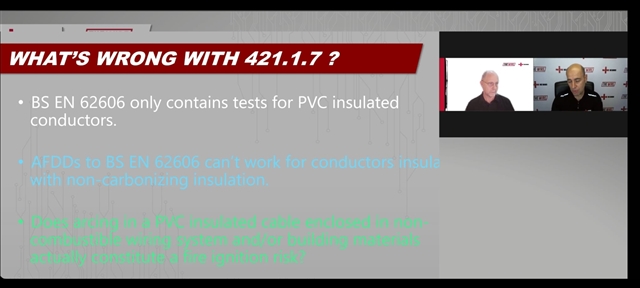Hi,
Does AFDDs work with LSF cabling...on the latest episode of the wire they stated that they have only been tested to PVC cabling? (see image below)

Hi,
Does AFDDs work with LSF cabling...on the latest episode of the wire they stated that they have only been tested to PVC cabling? (see image below)

There is a more general problem, that there are a great many sorts of arc that an AFDD may well not detect, or at least any AFDD that does is likely to also trip on perfectly normal events like contactors closing and motors with grotty brushes.
The European test standard for AFDDS IEC 62606 (AMD2 nov 2022) is quite unusual compared with the rest of the body of standards for things like RCDs MCBs switch-gear etc.
Firstly testing methods are relatively qualitative, as opposed to quantitative - involving for example a fair amount of near magical pre conditioning of wires and some 'Heath Robinson' test methods ( pages 20-21 of this document reproduces the same ideas as the original standard )
Secondly it is trying to standardise a technology that is very much still a work in progress (https://ieeexplore.ieee.org/stamp/stamp.jsp?tp=&arnumber=9889731 for example is yet another widely differing arc detection algorithm, new this year - this is not a sign of stability.. )
The problem is we really cannot easily tell if the char from non PVC cables does or does not behave the same, and if anyone authoritative does know, they certainly have not published it.
If anything what little info is in circulation probably supports the opposite view that arcs in non PVC cable are not likely to be detected with current devices.https://www.cibsejournal.com/technical/arc-detection-devices-fault-finding-mission/
It is not clear if insulation with fire suppressant in the plastics even forms a conductive char in the same way.
Interesting times
Mike.
That magical alchemy that normally damaged wires behave like ;-)
There is a more general problem, that there are a great many sorts of arc that an AFDD may well not detect, or at least any AFDD that does is likely to also trip on perfectly normal events like contactors closing and motors with grotty brushes.
The European test standard for AFDDS IEC 62606 (AMD2 nov 2022) is quite unusual compared with the rest of the body of standards for things like RCDs MCBs switch-gear etc.
Firstly testing methods are relatively qualitative, as opposed to quantitative - involving for example a fair amount of near magical pre conditioning of wires and some 'Heath Robinson' test methods ( pages 20-21 of this document reproduces the same ideas as the original standard )
Secondly it is trying to standardise a technology that is very much still a work in progress (https://ieeexplore.ieee.org/stamp/stamp.jsp?tp=&arnumber=9889731 for example is yet another widely differing arc detection algorithm, new this year - this is not a sign of stability.. )
The problem is we really cannot easily tell if the char from non PVC cables does or does not behave the same, and if anyone authoritative does know, they certainly have not published it.
If anything what little info is in circulation probably supports the opposite view that arcs in non PVC cable are not likely to be detected with current devices.https://www.cibsejournal.com/technical/arc-detection-devices-fault-finding-mission/
It is not clear if insulation with fire suppressant in the plastics even forms a conductive char in the same way.
Interesting times
Mike.
That magical alchemy that normally damaged wires behave like ;-)
We're about to take you to the IET registration website. Don't worry though, you'll be sent straight back to the community after completing the registration.
Continue to the IET registration site